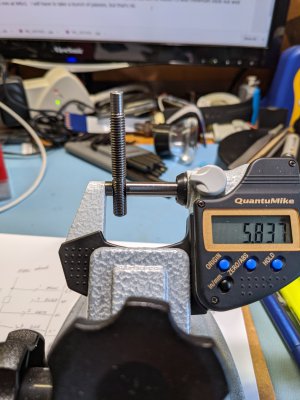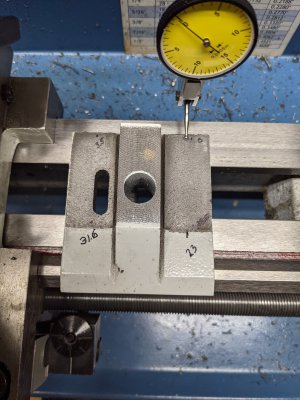- Joined
- Dec 18, 2019
- Messages
- 6,538
Finished the differential screw, but the M6x0.75 part is undersized. Major diameter is 5.838 at one end and 5.808 at the other. Minimum Major diameter should be 5.838. Will make another one. I screwed up at the end by hand screwing an HF M6x0.75 die on it. It was finger tight, meaning I could turn it using my fingers (not with a die stock), but it did shave some fine metal. The M6x1 is a little on the high side, but it is within the spec, so that was good.

Well, I'm buying some real taps and dies for this size, as I now know they are not true to size (6g). One day I'll replace the whole (wretched) set with something decent.
The third attempt will go a lot faster. (Kind of know what to do now!) The single thread wire method seemed to work ok, but you really need to clean the screw, no burs and no chips in the threads. Otherwise you get readings which don't repeat. I was threading under a magnifier so I could pick up the thread again, and to watch when to stop. That made it easier for me. (One day I can see adding a microscope camera to this set up. Magnification helped a lot!)
What messed me up in the beginning was using the dead center. Since it is no where near the spindle axis, the misalignment added a taper to the rod, which made subsequent operations more difficult.
I will SPT the rod in sections. First SPT 15 mm of M6x0.75 with minimum stick out and then put out the rod and SPT 25 mm at M6x1. I will have to take a bunch of light passes, on the 25 mm section but that's ok.
Thanks for the encouragement. Hoping the rest of this adjuster will be a lot more straightforward.

Well, I'm buying some real taps and dies for this size, as I now know they are not true to size (6g). One day I'll replace the whole (wretched) set with something decent.
The third attempt will go a lot faster. (Kind of know what to do now!) The single thread wire method seemed to work ok, but you really need to clean the screw, no burs and no chips in the threads. Otherwise you get readings which don't repeat. I was threading under a magnifier so I could pick up the thread again, and to watch when to stop. That made it easier for me. (One day I can see adding a microscope camera to this set up. Magnification helped a lot!)
What messed me up in the beginning was using the dead center. Since it is no where near the spindle axis, the misalignment added a taper to the rod, which made subsequent operations more difficult.
I will SPT the rod in sections. First SPT 15 mm of M6x0.75 with minimum stick out and then put out the rod and SPT 25 mm at M6x1. I will have to take a bunch of light passes, on the 25 mm section but that's ok.
Thanks for the encouragement. Hoping the rest of this adjuster will be a lot more straightforward.


